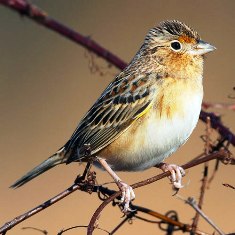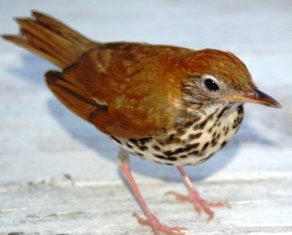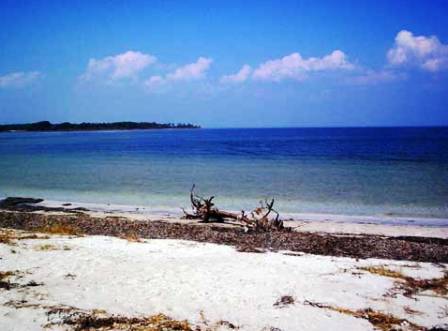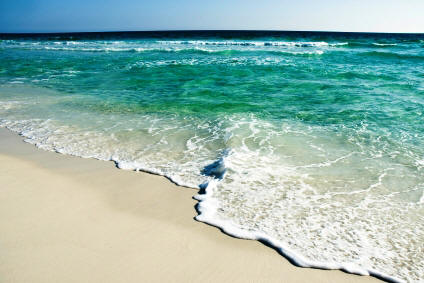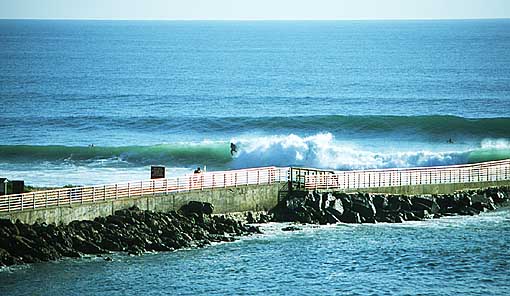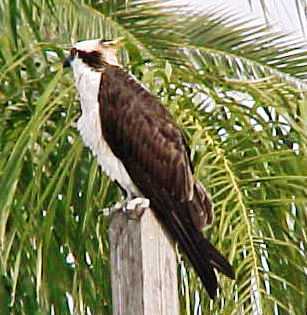Spring is in the air and the Florida birds are all chirping about the great weather. From the time I wake up until I close my eyes at the end of the evening, I can always hear a variety of birds in my back yard. Although they don't always get along with each, I appreciate each and every one of them for their beauty, musical notes, and for making my backyard a lot more interesting. Florida grasshopper sparrows are small, short-tailed birds, about 5
inches long and weighing less than one ounce. This not so drab sparrow
is mostly black and gray with some brown streaks on the back.
Underneath, it is light gray or buff color with no streaking. Feathers
at the bend of the wing are bright yellow and there is an orange patch
in front of the eyes. A white stripe marks the top of the head. The
male’s primary song is weak and grasshopper-like, giving rise to the
bird’s common name.
Like most Floridian backyards we have some Florida scrub jays, with one dominant male that visits my bird bath almost every afternoon. The Florida scrub-jay is a 12-inch-long, blue and gray crestless jay
that lacks the white wing spots and tail feather tips of the more common
and widespread blue jay. A necklace of blue feathers separates the
whiter throat from the gray whitish forehead. The tail is long and loose
in appearance, and the back is gray.
The song of the wood thrush is so beautiful it inspired
Handel to write a piece of music in the bird's honor. There is no more
lovely a sound than the loud, flute-like song, ending in a trill, of
this songbird. The wood thrush is large and plump, reddish-brown above
and whitish below, with large dark spots on its throat, breast and
sides. It has a bold, white eye ring and its tail is short. It is often
tied to shade-grown coffee plantations in South America for winter
survival, since it requires shady areas. Spring brings it returning to
North America to breed in moist deciduous forests.
Wednesday, April 29, 2015
Tuesday, April 21, 2015
Nature Spot of the Week: St. Joseph Peninsula State Park
St. Joseph Peninsula State Park in Florida is truly a dream come true for Floridian nature lovers! The park is teeming with wildlife and marine life. Noted as an excellent birding area with sitings of 209 species currently recorded, it is a premier location in the eastern United States for observing hawks during fall migration. Many species can be seen including the endangered peregrine falcon. The monarch butterfly is also on the wing in autumn, making its long migratory journey from northern states to wintering sites in Mexico. Shore and wading birds are in abundance throughout the year. While the best area of the park to observe birds is along the beach and bayshore, the sandpine scrub, pine flatwoods and dunes offer protective habitat. The shallow waters of St. Joseph Bay are alive with a variety of marine life. Frequently encountered are bay scallops, hermit, fiddler and horseshoe crabs and octopi.
A long barrier extending north between St Joseph Bay and the Gulf of Mexico, this 2516 acre park will appeal to a wide range of interests. Its miles of fine natural beach are good for swimming and fishing. With miles of white sugar sand, this park has one of the top rated beaches in the United States. Sunbathing, snorkeling, and swimming are popular activities along the Gulf of Mexico and St. Joseph Bay. Outdoor enthusiasts can enjoy camping, fishing, hiking, and bicycling. From offshore, canoeists and kayakers can take in a superb view of the high dunes and sand pine scrub. The fall is best for catching large redfish, sharks, bluefish, and flounder, while spring is excellent for pompano, whiting, and speckled trout.
Wednesday, April 15, 2015
Floridian Nature Nature Spot of the Week: Henderson Beach State Park
Henderson Beach State Park has one of
Florida's greatest natural assets, sugar white sand beaches. The centerpiece
of this park is the expansive white-sand beach that provides a variety of
different experiences, from swimming and sunning to dolphin watching and
shelling. Swimming is permitted at Henderson Beach State Park but lifeguards
are not provided. However, swimming safety flags are posted each day in
order to help visitors determine whether or not they should swim. Surf
fishing is permitted at the park with the proper license. Anglers can expect
to catch pompano, flounder, catfish, redfish, whiting, and a few other
species. Two large pavilions allow for picnicking and grilling. A playground
is the first stop on our nature trail and is sure to be a success with the
kids. The nature trail provides visitors a rare glimpse of the coastal dune
ecosystem and abundant wildlife and is pet friendly.
The most common dolphin in Florida waters is the
bottle-nosed dolphin. Bottlenose dolphins have robust, powerful bodies
that are blue-gray on top with lighter sides and bellies. This dolphin
has an unusually short and stubby beak, hence the name "bottlenose". The
bottlenose dolphin has more flexibility in its neck than other oceanic
dolphins. As adults they are typically six to twelve feet long, and live
both inshore and offshore along temperate and tropical coasts worldwide.
Dolphins breathe air at the surface of the water through a single
blowhole located near the top of the head. They need to breathe about
every two minutes, but can hold their breath for several minutes. Their
blow is a single, explosive cloud. Feeding behaviors for the bottlenose
dolphin are diverse, primarily involving individual prey capture, but
sometimes involving coordinated efforts to catch food, feeding in
association with human fishing, and chasing fish into mud banks.
Bottlenose dolphins eat a wide variety of food, consuming more than 20
pounds of mullet,
sheepshead, pinfish, flounder and marine
invertebrates each day. Male bottlenose dolphins reach sexual maturity
at about 10 years. Females reach sexual maturity at about 5-10 years.
The gestation period is 12 months. Calving can take place year-round
with peaks in some areas during spring and fall. Calves nurse for over a
year (12-18 months), and stay with their mothers for 3-6 years learning
how to catch fish and other important tasks.
In 2001, volunteers helped build a 3/4 acre nature trail at Henderson.
The trail winds through a number of different kinds of vegetation
including sand pines, scrub oaks, and dune rosemary, also known as
coastal scrub. The trail climbs the park's gently sloping dunes and to
the top of a particularly high dune that is the remnants of a bunker
built decades ago when the military made use of the area around
Henderson Beach. This vantage point provides great views of the park and
the Gulf of Mexico.
Wednesday, April 8, 2015
Floridian Nature Vacation Spot of the Week: Sebastian Inlet State Park
Sebastian Inlet State Park
is a Florida State Park located 10 miles south of Melbourne Beach and 6
miles north of Vero Beach, Florida. The park lies on both sides of the
Sebastian Inlet. In 2006, it was the sixth most visited state park in
Florida. Wildlife is abundant in the park, and the casual visitor can
reasonably hope to see ospreys and many species of shorebird. Sea
turtles nest in the park, and visitors during the summer may make
reservations for a nighttime foray to observe nesting Loggerhead
Turtles.
Sebastian Inlet State Park is
the premier saltwater fishing spot on Florida's east coast, this park
is a favorite for anglers nationwide for catching snook, redfish,
bluefish, and Spanish mackerel from its jetties. Surfing is also a
popular recreation and several major competitions are held here every
year. Three miles of beautiful beaches provide opportunities for
swimming, scuba diving, snorkeling, shelling, and sunbathing. Canoeing
and kayaking in the Indian River Lagoon are also favorite pastimes.
Visitors can relax with a stroll down the mile-long Hammock Trail.
Waterfront pavilions and picnic areas are great for family outings. The
park mainly provides leisure activities, particularly fishing from both
its Atlantic and Indian River shores; fishing jetties extend from both
sides of the inlet into the ocean. There are facilities for swimming,
surfing, snorkeling and scuba diving from the 3 miles of Atlantic beach.
Boats can be launched into the Indian River, and there is a marina
complex at the north end of the park. Camping is permitted in designated
area. Sebastian Inlet State Park is a must visit for Floridian nature
lovers!
Sebastian Inlet is also where this picture was taken. I found this on FWC's Facebook page and they said the photo was supplied by John
Bailey, who took this amazing picture. He reportedly spotted a bobcat staring into
the water at Sebastian Inlet State Park last evening while he was taking
a stroll. He realized the cat was transfixed on a shark feeding on
smaller fish. Suddenly, the bobcat
leaped into the water atop the shark and dragged it ashore! Bailey took
the photo and the cat dropped its catch and ran into the forest.
Subscribe to:
Posts (Atom)
